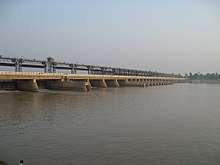Islam Barrage
| Islam Barrage | |
|---|---|
 | |
.jpg) Location of Islam Barrage in Punjab, Pakistan  Islam Barrage (Pakistan) | |
| Official name | Islam Headworks |
| Country | Pakistan |
| Location | Hasilpur Tehsil, Bahawalpur District[1] |
| Coordinates | 29°49′35″N 72°32′57″E / 29.82639°N 72.54917°ECoordinates: 29°49′35″N 72°32′57″E / 29.82639°N 72.54917°E |
| Purpose | Irrigation, Flood Control |
| Construction began | 1922[1] |
| Opening date | 1927[1] |
| Dam and spillways | |
| Impounds | Sutlej River |
Islam Barrage is a barrage on the River Sutlej in Hasilpur Tehsil of the Punjab province of Pakistan
Islam Barrage is used for irrigation and flood control. It is about 15 kilometres (9.3 mi) north of Hasilpur and about 7.5 kilometres (4.7 mi) south of Luddan on the Vehari-Hasilpur road. It was completed as Sutlej Valley Project[1] for irrigation of Nili Bar in 1927. 1650 feet long with design discharge of 300,000 cusecs, it has two off taking larger canals which irrigate 689,000 acres of land in Southern Punjab and 700, 000 acres in the former Bahawalpur state. Mailsi Canal (5400 cusecs) arises from its right Bank and Bahawal Canal (5400 cusecs) from the left. A third smaller canal is called Qaim Canal (558 cusecs) also arising from the left bank.
According to a report, Islam Headworks is in distress owing to aging, design deficiencies, constructional defects, hydraulic and mechanical problems, inadequate operation, maintenance and drastic changes in river morphology as a result of implementation of Indus Water Treaty of 1960.
The major problem was inadequate flood passage capacity of barrage in relation to flood intensities developed over a 100-year return period. The aging process along with inadequate/deferred maintenance had contributed to a general deterioration of different components of the structure.
The poor structural state of the headworks has been documented to be poor in June 1998, due to inattention, lack of interest, and the operations of the headworks has suffered. Every September when the flood level rise and India releases a large amount of water, it creates havoc in areas downstream from the head works.
A feasibility study and detailed designs was prepared in 2008 to rehabilitate the Headworks. However due to lack of interest, inefficiency at the government level and absence of confidence/trust of International Financial Institutions (IFIs) has contributed to postpone the rehabilitation. World Bank (WB) has given verbal assurance for financing the rehabilitation of Islam headworks but it would be only after rehabilitation of another barrage (Jinnah). More recently the Punjab government has obtained assurances from the World Bank and the Provincial Government of Shahbaz Sharif has begun to take interest in rehabilitation of the headworks. 2013 floods which caused a significant damage throughout Punjab may have been an impetus in leading to this more proactive policy.
According to a 2011 report,[2] River Sutlej at this point is the most polluted river in South Asia. The combined unregulated discharge of Urban and Industrial waste during its course through India and later Pakistan is the most likely source of this problem.
This barrage is a tourist site for those who want to visit nearby restaurants that sell fresh fish. Most of the tourist are from nearby towns. However it can be developed into a eco-tourism site for those who are interested in study of the hydrology of Indus basin and the effect of shortage of water in this part of the world. The desertification of the area from the nearby Choolistan desert is an interesting phenomenon and the pollution of the river from upstream industry in India is a cause of concern.
See also
References
- 1 2 3 4 Ahmad Ahmadani (3 November 2010). "Lack of funds threatens Islam Headworks". The Nation. Islamabad. Retrieved 27 May 2017.
- ↑ Riaz Missen. "Sutlej flows down to Bahawalpur but with poisonous waters". Archived from the original on 2015-02-03. Retrieved 27 May 2017.